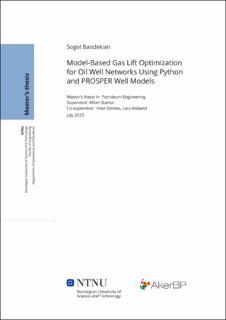| dc.description.abstract | In the oil industry, continuous flow gas lift is a frequently employed artificial lift technique to boost oil recovery by decreasing bottom hole pressure. By injecting high-pressure gas into the tubing, the oil column can be gasified, resulting in a more efficient production process. Although each oil well can obtain a significant amount of gas to achieve optimal production, the available injection gas is often inadequate because of constraints. Excessive gas injection in a field with a limited gas supply can be costly due to high gas prices and compressing costs, leading to a reduction in revenue. Thus, it becomes essential to distribute the injection gas efficiently among all wells to attain the highest oil production rate for the field. Mathematical optimization can be used to formulate and solve the problem of determining gas lift allocation per well for the purpose of maximizing oil production. By maximizing the nonlinear function that models the total oil production rate for a group of wells, the gas allocation can be optimized. The aim of this project is to optimize the oil production system and gas lift rate within the well networks.
GAP, a software for multiphase network modeling and optimization, utilizes model-based numerical optimization to determine the optimal allocation of gas lift injection for each well in the network. Gas-lift injection rates per well are determined by applying numerical optimization to a production system model, which helps identify the most efficient operational settings. The GAP model comprised six gas-lifted wells, two manifolds, and one separator, all spanning from the subsea to the surface.
Besides GAP, a Python-based tool is developed for performing model-based optimization for gas lift injection. For the proper functioning of this tool, two essential components, namely the model and the optimizer, were required. This tool operates through the following process. PROSPER, software for well modeling and nodal analysis, generated the well-model that portrays the behavior of six wells in a network during gas lift injection. The well models comprised free variables such as gas lift injection, liquid rate, water cut, wellhead pressure, and gas-oil ratio. Additionally, the models contained calculated variables that relied on the free variables, including bottom-hole pressure and temperature. The free variables remained consistent across all six wells in the network, whereas the calculated variables varied.
The optimization for well networks was performed through the utilization of scipy.optimize.minimize and some special algorithms in Python. To perform optimization using well-model files, the initial step involved importing the data from the files into Python. The JSON format was utilized to read and store the necessary data. The code implemented for the purpose of reading well models can effectively handle a diverse range of free and calculated variables. Afterward, a class was defined for performing multidimensional interpolation of data points with a cubic method. The unit conversion methods in this class aligned with Norwegian standards. Before proceeding with gas lift optimization, the function for determining the equilibrium flow rates of each well in the network must be established. To maximize the oil production for each well, the last method used in this tool was finding the optimal values of gas lift injection. By implementing a nonlinear optimization technique that took into account constraints and an objective function, the optimal gas injection rates were determined.
By simulating the tool in Python, the gas lift injection was allocated to maximize oil production while meeting technical and operational constraints. The major features of this tool are its abil-ity to function with multiple well numbers and adjust well inputs without impacting its perfor-mance. The results indicate that both Python and GAP optimization methods exhibited similar performance, with negligible deviations between the two models for the majority of the pro-cess. Additionally, the findings demonstrate that conducting sensitivity analysis in both GAP and Python can provide a more comprehensive understanding of how to optimize oil production in the field, accounting for factors such as restricted water production and choke configuration.
The presence of numerous wells, coupled with complex operational and technical constraints and the need for choke setting optimization, can result in GAP experiencing prolonged search times or a potential failure to arrive at a solution. Additionally, obtaining access to the GAP software proves challenging, as one must purchase a license to operate it. The Python solver enables gas lift optimization with simple input variable management for users and has the po-tential for optimization using real well models. | |
